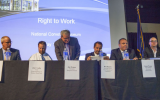2017: A Year in Review for Labor

2017 was truly an outstanding year for worker freedom.
On January 31, 2017, President Donald Trump nominated Justice Neil Gorsuch to the Supreme Court, and on April 10, 2017, Gorsuch took the oath of office.
With Gorsuch confirmed, there are now 5 worker freedom advocates on the Supreme Court.
As a result, this new Court decided to hear the Janus v. AFSCME case. The case will decide whether government employees are forced to pay fees to a union they have chosen not to join. Illinois Governor Bruce Rauner (R) first brought the case to protect Illinois government workers.
If the Court rules against the fees, this case will bring more freedom to government workers. No longer will these workers have to turn over their hard-earned money to a union they don’t support.
In addition, President Donald Trump nominated William Emanuel and Marvin Kaplan to the National Labor Relations Board, along with Peter Robb as General Counsel. As a result, the NLRB was able to overturn at least 5 Obama Administration NLRB cases. The Obama Administration decisions were burdensome and costly for employers and hurt workers.
One example of a case that was overturned was the 2015 Browning Ferris decision. In 2015, the NLRB changed the joint employer standard and increased the potential liability of franchises and small businesses with contract employees. With the recent December decision, the prior joint employer standard has been reinstated.
On the state level, two states became Right to Work. Kentucky Governor Matt Bevin signed Right to Work into law on January 7, 2017, and Missouri Governor Eric Greitens signed Right to Work into law on February 6, 2017. In addition, Iowa Governor Terry Branstad signed public sector labor reform into law on February 17, 2017.
Further, Seaford, Delaware; Sussex County, Delaware; and Sandoval County, New Mexico introduced local Right to Work ordinances, expanding freedom on the county and city level.
Finally, workers themselves actually fought successfully for their freedoms. Mississippi Nissan workers and South Carolina Boeing workers both voted to keep their freedom to negotiate with their employers.
Despite these victories, there were some disappointments. New Hampshire Representatives failed to give New Hampshire workers the freedom to choose whether to join a union or not. In addition, Minnesota Governor Mark Dayton (DFL) and the Bureau of Mediation Services have not allowed another union representation election for homecare workers even after union fraud in the initial election was discovered. Homecare workers have already filed the required number of cards for a new election.
Despite a couple of disappointments, the Center for Worker Freedom was proud to be involved in most of these victories and looks forward to another great year in 2018.





